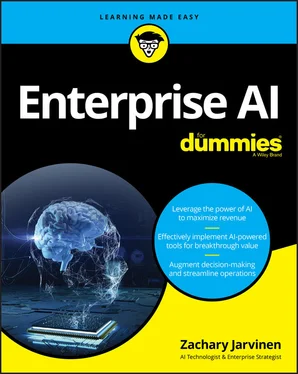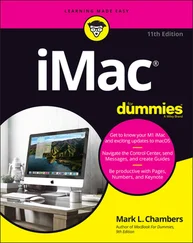261 271
262 272
263 273
264 275
265 276
266 277
267 278
268 279
269 280
270 281
271 282
272 283
273 284
274 285
275 286
276 287
277 288
278 289
279 290
280 291
281 292
282 293
283 294
284 295
285 297
286 298
287 299
288 300
289 301
290 302
291 303
292 304
293 305
294 306
295 307
296 308
297 309
298 310
299 311
300 312
301 313
302 314
303 315
304 316
305 317
306 318
307 319
308 320
309 321
310 322
311 323
312 324
313 325
314 326
315 327
316 328
317 329
318 330
319 331
320 332
321 333
322 334
323 335
What we want is a machine that can learn from experience.
— Alan Turing, Lecture to the London Mathematical Society, 20 February 1947
The whizbang aspects of artificial intelligence get lots of press and screen time. Consider a few recent headlines:
The U.S. Army is creating robots that can follow orders.
DeepMind’s AI has now outcompeted nearly all human players at StarCraft II.
A robotic hand taught itself to solve a Rubik’s Cube after creating its own training regime.
A new AI fake text generator may be too dangerous to release, say creators.
This AI bot writes such convincing ads that Chase just “hired” it to write marketing copy.
Remember back when the caption “Wi-Fi Ready” or “Bluetooth Ready” was stamped in a starburst graphic on the front of boxes for everything from televisions to refrigerators? AI has now reached that exalted status.
Of course, you have the smart speaker of your choice and maybe a smart thermostat. But wait, there’s more. You can get an AI-powered toothbrush that tattles to your smartphone about your brushing habits, via Bluetooth of course. An AI-enabled pill dispenser reminds you to take your medicine. And an AI-powered vacuum cleaner tidies up before the dinner guests arrive.
But AI is not just about gadgets and novelties. It also keeps the store from running out of water, batteries, and strawberry-flavored Pop-Tarts during hurricane season. It makes sure that a factory doesn’t exceed emissions standards. It figures out supply chain logistics, taking into account product quality, weather, tariffs, geo-political hotspots, compliance, and a host of other factors.
AI is also about increasing revenue and creating jobs. Yes, you read that last part right. Contrary to common warnings, AI could boost employment levels by 10 percent if the rest of the world invested in AI and human-machine collaboration at the same level as the top performing 20 percent.
In this current AI renaissance, new advances appear on a near-daily basis, and that’s a good thing. But this book isn’t about the new, sexy, flashy, bleeding-edge, headline-grabbing utopian AI. It isn’t about the futuristic dystopian AI dreams portrayed in movies, books, and conspiracy theories either.
This book is about what AI can do for you, right now, in your business. It’s about well-established, tried-and-true technology and processes that are currently being used in businesses and organizations all over the world to help humans become more productive, more accurate, more efficient, and more understanding.
What you won’t find in this book:
Deep dives into the mathematics and science underpinning AI
Coding tutorials, examples of coding, or coding exercises
Libraries and packages that you have to download and install
Exercises to complete or problems to solve
What you will find in this book:
A survey of the market drivers for AI and the enabling technology that makes it possible
A very high-level, layperson’s overview of the algorithms and techniques that pragmatic AI uses
A quick stroll down AI memory lane to see if you recognize early implementations you likely used
Some tips on picking a solid use case for your first AI project for your business
A survey of 21 vertical and horizontal markets to see how pragmatic AI can help you now
Strong, Weak, General, and Narrow
Often, people don’t differentiate between the AI that checks the grammar on your resume and the AI that becomes Skynet and ushers in the robot apocalypse. Just like coffee, ice cream, Pringles, and Pop-Tarts, AI comes in many flavors, but at a high level, it falls into two categories:
Strong/general AI: Also known as artificial general intelligence (AGI), general AI is an intelligence that is indistinguishable from human intelligence. In other words, for now, AGI resides solely in the land of science fiction and speculation.
Weak/narrow AI: In contrast to general AI, narrow AI lives firmly in the land of the now and the real. Each implementation has a very targeted (hence narrow) focus on accomplishing a specific, practical task. In fact, narrow AI is often called practical or pragmatic AI.
Pragmatic artificial intelligence is the subject of this book. You can apply AI to many problems, but in your business, the solutions all fall under three business goals.
 Every enterprise AI project aims to reduce cost, increase revenue, or explore new business models.
Every enterprise AI project aims to reduce cost, increase revenue, or explore new business models.
As you read about the various vertical and horizontal markets and the related use cases, I might talk about workflow optimization or recommendation engines or predictive maintenance, but ultimately every use case falls under one of these three goals.
I am assuming that you, the reader, fall into one or more of the following categories:
You have a college-level education, such as a bachelor’s degree, MBA, or professional certifications, or are pursuing a business degree.
You read trade publications and books on business management.
You possibly have leadership and/or IT skills, but not necessarily programming knowledge.
You fall somewhere on the spectrum between:Business executive and decision-maker at a mid-sized to large organizationConsultant and strategic advisor, formal or informalAmbitious junior and up-and-coming employeeBusiness school or related student
As you read this book, you see icons in the margin that indicate material of interest. This selection briefly describes each icon in this book.
 Everybody likes a tip, a little inside knowledge about a good thing. A life hack. A hint about how to save time or money. How to make things easier. This icon marks the spot where the goods are buried.
Everybody likes a tip, a little inside knowledge about a good thing. A life hack. A hint about how to save time or money. How to make things easier. This icon marks the spot where the goods are buried.
 A few things are good to know, and remember, about how AI works. This icon reminds you to remember those things — and makes it easy to find them again if you forget to remember.
A few things are good to know, and remember, about how AI works. This icon reminds you to remember those things — and makes it easy to find them again if you forget to remember.
 This icon is the reverse of a tip. It tells you how to avoid the bad thing. You see this? Don’t do that.
This icon is the reverse of a tip. It tells you how to avoid the bad thing. You see this? Don’t do that.
 Once or twice for a second or so, the book gets down in the weeds, kicks over a rock to see what’s underneath. If you like that kind of thing, when you see this icon, keep on reading. If not, just skip it. You won’t miss anything you can’t live without.
Once or twice for a second or so, the book gets down in the weeds, kicks over a rock to see what’s underneath. If you like that kind of thing, when you see this icon, keep on reading. If not, just skip it. You won’t miss anything you can’t live without.
Читать дальше

 Every enterprise AI project aims to reduce cost, increase revenue, or explore new business models.
Every enterprise AI project aims to reduce cost, increase revenue, or explore new business models. Everybody likes a tip, a little inside knowledge about a good thing. A life hack. A hint about how to save time or money. How to make things easier. This icon marks the spot where the goods are buried.
Everybody likes a tip, a little inside knowledge about a good thing. A life hack. A hint about how to save time or money. How to make things easier. This icon marks the spot where the goods are buried. This icon is the reverse of a tip. It tells you how to avoid the bad thing. You see this? Don’t do that.
This icon is the reverse of a tip. It tells you how to avoid the bad thing. You see this? Don’t do that. Once or twice for a second or so, the book gets down in the weeds, kicks over a rock to see what’s underneath. If you like that kind of thing, when you see this icon, keep on reading. If not, just skip it. You won’t miss anything you can’t live without.
Once or twice for a second or so, the book gets down in the weeds, kicks over a rock to see what’s underneath. If you like that kind of thing, when you see this icon, keep on reading. If not, just skip it. You won’t miss anything you can’t live without.










